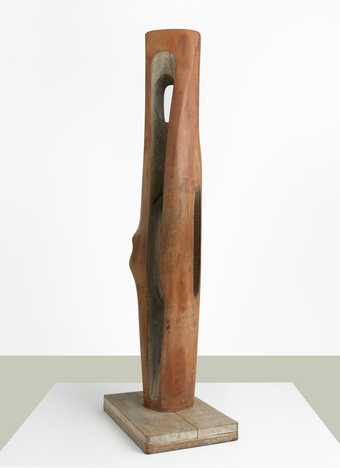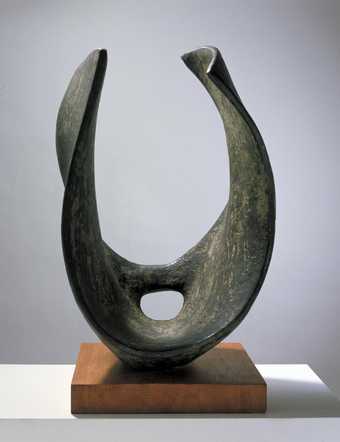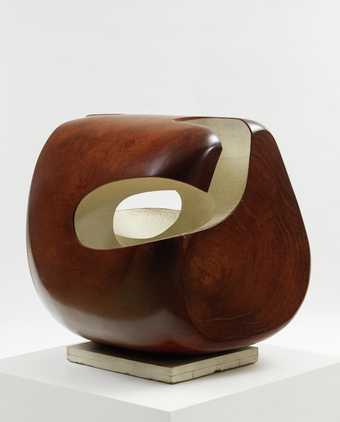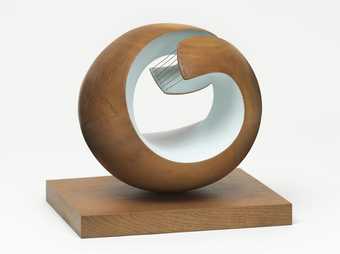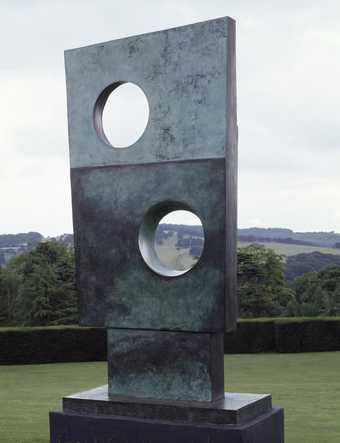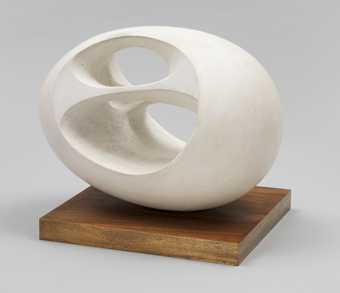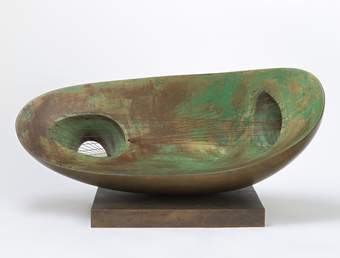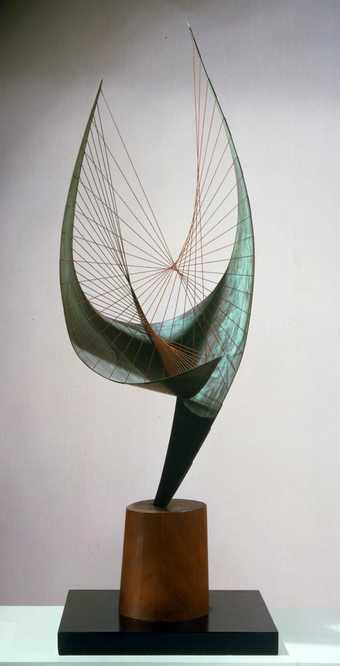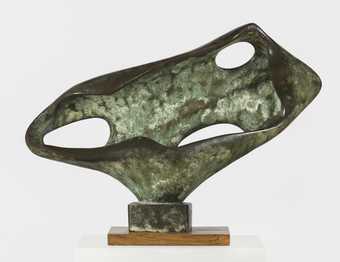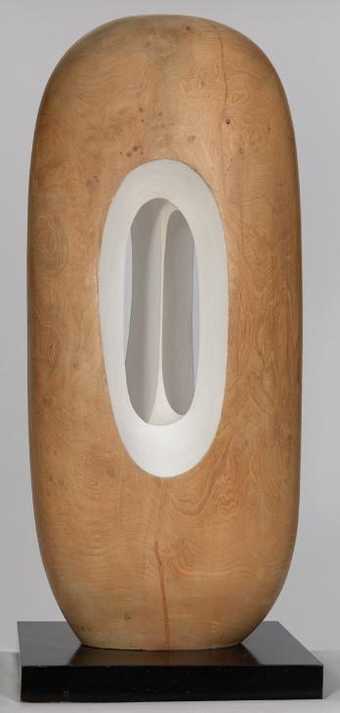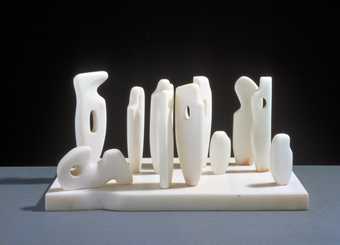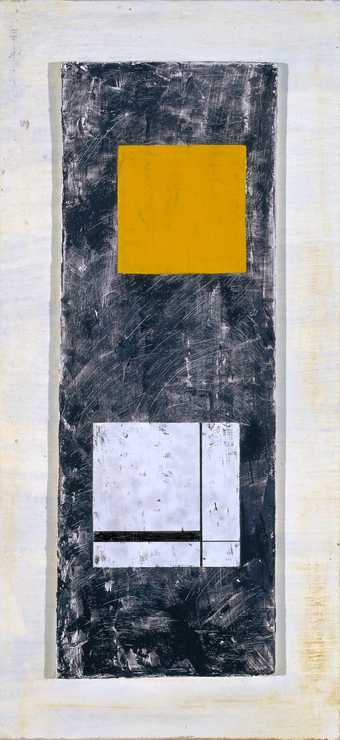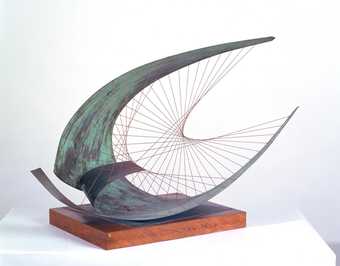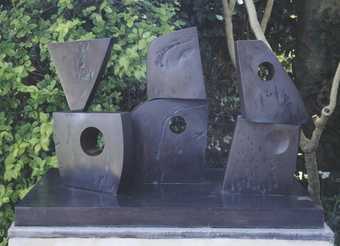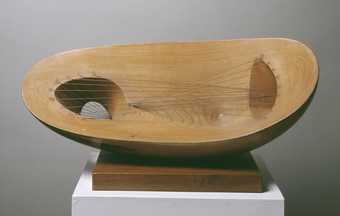
Not on display
- Artist
- Dame Barbara Hepworth 1903–1975
- Medium
- Holly
- Dimensions
- Object: 337 × 632 × 298 mm
- Collection
- Tate
- Acquisition
- Presented by Ben Nicholson OM 1975
- Reference
- T02008
Display caption
This sculpture belongs to a group of oval wood carvings dating from the mid-1940s. The splits in the wood occurred while the work was in progress, and so the artist abandoned it unfinished. Nonetheless, the sculpture embodies a strong empathy with the Cornish landscape which inspired it, and with the material used: 'I believe that the understanding of the material and the meaning of the form being carved must be in perfect equilibrium.' There is another, smaller version, 'Tides II', which was executed in the same year. This sculpture was presented to the Tate Gallery by Ben Nicholson in the year of Hepworth's death.
Gallery label, September 2004
Does this text contain inaccurate information or language that you feel we should improve or change? We would like to hear from you.
Catalogue entry
Dame Barbara Hepworth
1903-1975
T02008 Tides I
1946
Part painted wood (holly)
335 x 630 x 290 (13 1/4 x 24 7/8 x 11 3/8)
Presented by Ben Nicholson OM 1975
Provenance:
Acquired by Ben Nicholson early 1950s
Literature:
J.P. Hodin, Barbara Hepworth, Neuchâtel and London 1961, p.166 no.139
Tate Gallery Acquisitions 1974-6, London 1976, pp.105-6, repr. (upside down)
David Orchard, The Techniques of Wood Sculpture, London 1984, p.73, repr. (upside down)
David Lewis, 'St Ives: A Personal Memoir 1947-55' in St Ives: Twenty Five Years of Painting, Sculpture and Pottery, exh. cat., Tate Gallery, London 1985, p.36, repr. (upside down)
Penelope Curtis, Modern British Sculpture from the Collection, Tate Gallery Liverpool 1988, p.52, repr. (upside down)
Sally Festing, Barbara Hepworth: A Life of Forms, London 1995, p.172
Alun R. Graves, 'Casts and Continuing Histories: Material Evidence and the Sculpture of Barbara Hepworth' in David Thistlewood (ed.), Barbara Hepworth Reconsidered, Liverpool 1996, pp.173-5, repr. (upside down)
Reproduced:
David Fraser Jenkins, Barbara Hepworth: A Guide to the Tate Gallery Collection at London and St Ives, Cornwall, London 1982, p.27 (upside down)
In 1946 Barbara Hepworth wrote: 'I prefer the foreign hardwoods with their great variety of colour and surface finish. The war stopped all imports of foreign timber and I have been seasoning my own logs from trees felled in the Cornish woods' ('Approach to Sculpture', Studio, vol.132, no.643, Oct. 1946, p.98). It was such expediency that, at the beginning of the same year, had led her to carve this work from a piece of holly - a wood notoriously prone to splitting.
The dramatic splits in Tides I
appeared while the artist was still working on the piece. She wrote to Ben Nicholson, staying in London, in early 1946: 'On Sat. night I'd smoothed up my new wood carving [sketch] & applied colour to see what it looked like - I thought it one of my best and went to bed smiling. Sun. morn. I found 3 ENORMOUS cracks in it - This morning 3 more. I can only think that I smoothed it too soon and blocked the pores' (TGA: 8717.1.1.354). The artist reworked the idea later in 1946 in plane wood; the result was Tides II
(Michael and Rachel Kidd, repr. Hodin 1961, pl.140, comparative illustration), which was shown at her exhibition at the Lefevre Gallery in October of that year as Tides. The two works were differentiated as Tides I and Tides II in Alan Bowness's catalogue of the artist's work (Hodin 1961). Tides I has often been reproduced upside down. If it is orientated correctly, with the largest split on the left hand side and the three parallel splits to the right, one can see that Tides II was a fairly close replication of the earlier version.
Though most of the surface of Tides I has a smooth finish, there are areas where fine chisel and gouge marks are evident around the main curves of the form. A small area of the outer surface has not been finished and was, presumably, the face on which the sculpture sat while being carved. Tate Gallery conservators have suggested that pale grey paint was applied to the wood after it had split (Tate Gallery Conservation Files). This would suggest that either the artist continued to work on it or that Ben Nicholson added another coat of paint while it was in his possession. The wood has darkened under the painted area, giving the pigment a cool effect. Flecks of a dark blue can be seen in the paint layer and there are streaks of purple and blue paint on the back of the sculpture which were presumably applied accidentally. On acquisition by the Tate Gallery it was found that, since being carved, the wood had been subject to boring by woodworm of a size consistent with a seaside location. Tate Gallery conservators have reported that the work has been waterlogged in the past and suggested that it was damp at the time of carving (ibid.).
The condition of Tides I may be accounted for by its history. It would seem that the artist abandoned this work shortly after it split and discarded it in the garden of Chy an Kerris, her home in Carbis Bay. David Lewis has described the circumstances of its later rediscovery. After Hepworth and Nicholson had divorced, Lewis helped Nicholson tidy the garden at Chy an Kerris before he moved into St Ives. 'One afternoon I went at the docks and nettles with a billhook', Lewis wrote,
Deep in the weeds under a granite wall I found a wood carving of Barbara's. One can only assume that Barbara had thrown it out four years earlier, but who knows for sure. Anyhow, there it was, sodden from rain, cracked and worm-eaten, with moss in its inner cavities where paint colour had flaked. Ben said: "David, you found it, you should keep it." I said: "Ben, that's very generous, but surely it's Barbara's. She should decide what's to be done with it." But Ben and Barbara were not on speaking terms, so the sculpture was put in a box.
(Lewis 1985, p.36)
Tides I remained in Nicholson's collection until after Hepworth's death. In 1966 he sent her photographs of it, prompting her to observe, 'It is so much more beautiful than the second version! The photo might persuade people to put up with cracks in wood' (letter, 26 Feb. 1966 TGA 8717.1.1.363). Before giving the work to the Tate, Nicholson told the director, Norman Reid, that he believed it to be one of the finest examples of Hepworth's work and explained that he was presenting it 'in response to a request made by Dame Barbara in her lifetime' on the condition that no attempt was ever made to fill the splits in the wood (letter, 6 Nov. 1975, Tate Gallery acquisition files). Reid gave a guarantee to that effect (letter, 18 Nov. 1975).
The wave-like serpentine curve that characterises Tides I may be the source of the work's title. However, the sinuous division of its face and the piercing of each section is also reminscent of the Yin-Yang symbol. In ancient Chinese philosophy the concept of Yin-Yang represents the two contrasting forces of life in a harmony of opposites, by which existence is seen as a dynamic process of complementary, interdependent principles alternating in space and time such that cosmic time is seen as rhythmic. Within the harmony of Yin-Yang all things are related so that man is in unity with Nature. The infinite repetition of the tides - of which Hepworth would have been especially aware living by the sea - might be seen to encapsulate the essence of such a natural rhythm. Though Hepworth described herself at that time as an atheist (letter to E.H. Ramsden, nd [1944], TGA 9310), there was considerable interest in Eastern philosophy and religion amongst artists in St Ives during the 1940s. In particular, her close friend Bernard Leach had had direct contact with Eastern thought since the early years of the century and was a practicing Baha'i. Taoist philosophy - to which the concept of Yin-Yang is fundamental - was of particular current interest to younger artists such as Bryan Wynter and Sven Berlin with whom Hepworth associated. It is likely that she would have been conscious of the similarity of Tides
to the Yin-Yang symbol and one might, therefore, speculate that the title was intended to have more metaphysical resonances. The concepts of harmonious interdependency and the unity of man and nature were certainly consistent with her personal philosophy.
Chris Stephens
March 1998
Explore
- abstraction(8,615)
-
- from recognisable sources(3,634)
-
- landscape(1,191)
- non-representational(6,161)
- formal qualities(12,454)
-
- rhythm(101)
- cosmos(28)
- religious(106)
You might like
-
Dame Barbara Hepworth Figure (Nanjizal)
1958 -
Dame Barbara Hepworth Curved Form (Trevalgan)
1956 -
Dame Barbara Hepworth Corinthos
1954–5 -
Dame Barbara Hepworth Pelagos
1946 -
Dame Barbara Hepworth Squares with Two Circles
1963 -
Dame Barbara Hepworth Oval Sculpture (No. 2)
1943, cast 1958 -
Dame Barbara Hepworth Landscape Sculpture
1944, cast 1961 -
Dame Barbara Hepworth Orpheus (Maquette 2) (Version II)
1956, edition 1959 -
Dame Barbara Hepworth Sea Form (Porthmeor)
1958 -
Dame Barbara Hepworth Hollow Form with White
1965 -
Dame Barbara Hepworth Group I (Concourse) February 4 1951
1951 -
Dame Barbara Hepworth Two Forms (White and Yellow)
1955 -
Dame Barbara Hepworth Stringed Figure (Curlew), Version II
1956, edition 1959 -
Dame Barbara Hepworth Six Forms (2 x 3)
1968 -
Dame Barbara Hepworth Landscape Sculpture
1944

